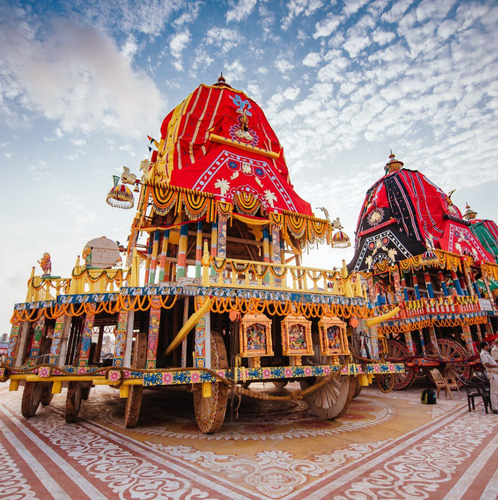
Jagannatha Ratha Yatra, also known as the Chariot Festival, is one of the most significant and vibrant festivals in Hinduism, celebrated primarily in Puri, Odisha. This grand festival is dedicated to Lord Jagannatha (a form of Lord Krishna), his brother Balabhadra, and sister Subhadra. The Ratha Yatra marks the annual journey of these deities from their temple to the Gundicha Temple, situated about 3 kilometers away, and back. The festival usually falls in the Hindu month of Ashadha (June or July).
Historical and Spiritual Significance
The tradition of Ratha Yatra dates back to ancient times and holds profound spiritual significance. It symbolizes the journey of the soul in the material world and the Lord’s willingness to come out of his sanctum to bless devotees. According to legend, the deities visit their aunt’s home during this period. The huge, elaborately decorated chariots (rathas) used in the procession are pulled by thousands of devotees, creating a majestic and mesmerizing spectacle.
Rituals and Preparations
Preparations for the Ratha Yatra begin weeks in advance. Devotees and temple priests engage in various rituals and ceremonies to ensure that the festival proceeds smoothly and in accordance with tradition. To participate in and celebrate Jagannatha Ratha Yatra, it is essential to have the right items for performing the puja (worship). These include agarbatti (incense sticks), dhoop (incense cones or sticks), and a comprehensive pooja kit.
1. Agarbatti (Incense Sticks)
Agarbatti, or incense sticks, play a crucial role in Hindu rituals. Their fragrant smoke is believed to purify the environment, create a serene atmosphere, and act as an offering to the deities. During the Ratha Yatra, lighting agarbatti in front of the deities’ images or idols helps devotees focus their minds and hearts in devotion. It symbolizes the transformation of the material offerings into spiritual ones.
2. Dhoop (Incense Cones or Sticks)
Dhoop, another form of incense, is known for its rich and intense fragrance. It is often used alongside agarbatti in Hindu rituals. The use of dhoop during the Ratha Yatra enhances the sanctity of the environment, creating a spiritually uplifting atmosphere. The thick smoke from dhoop is also believed to drive away negative energies, thus inviting positive vibrations and blessings from the deities.
3. Pooja Kit
A comprehensive pooja kit is essential for performing the various rituals associated with Jagannatha Ratha Yatra. A typical pooja kit includes:
- Idols or Pictures of the Deities: Beautiful idols or images of Lord Jagannatha, Balabhadra, and Subhadra for the altar.
- Kalash (Water Vessel): A metal or clay pot filled with water, symbolizing purity and the source of life.
- Panchamrit: A mixture of milk, yogurt, honey, ghee, and sugar used for the abhishekam (ritual bathing) of the deities.
- Flowers and Garlands: Fresh flowers and garlands for decorating the altar and offering to the deities.
- Coconut and Fruits: Offerings of coconut and various fruits as prasad (blessed food).
- Camphor and Ghee Lamps: Camphor for the aarti (ritual waving of light) and ghee lamps for lighting during the puja.
- Roli and Kumkum: Red powder (roli) and vermilion (kumkum) for applying tilak (mark) on the foreheads of the deities and devotees.
- Rice and Betel Leaves: Symbolic offerings used in various stages of the puja.
- Chandan (Sandalwood Paste): Used for applying sacred marks and for its fragrant and cooling properties.
- Bell: Used during aarti to create a divine sound that purifies the environment.
How to Perform the Puja
- Preparation: Clean the puja area and arrange all the items from the pooja kit on a clean cloth. Place the idols or images of Lord Jagannatha, Balabhadra, and Subhadra in the center.
- Invocation: Light the agarbatti and dhoop, and offer them to the deities while chanting mantras dedicated to them.
- Abhishekam: Perform the abhishekam with panchamrit, followed by water from the kalash.
- Decoration: Decorate the idols or images with flowers, garlands, and sandalwood paste.
- Offerings: Offer coconut, fruits, and sweets to the deities.
- Aarti: Light the camphor and ghee lamps, and perform the aarti while ringing the bell and chanting the holy names of the deities.
- Prayers: Sit in meditation and recite prayers or mantras dedicated to Lord Jagannatha, Balabhadra, and Subhadra, seeking their divine blessings.
- Conclusion: Distribute the prasad among family members and devotees.
Conclusion
Jagannatha Ratha Yatra is not just a festival; it is a profound spiritual journey that connects devotees to the divine. By observing this festival with devotion and performing the rituals with the essential items like agarbatti, dhoop, and a comprehensive pooja kit, devotees can invoke the divine blessings of Lord Jagannatha, Balabhadra, and Subhadra. This sacred observance reinforces the importance of devotion, prayer, and the pursuit of divine knowledge in one’s life. By immersing oneself in the rituals and festivities of Jagannatha Ratha Yatra, devotees experience a deep sense of spiritual fulfillment and joy, celebrating the divine journey of the deities and their own journey towards spiritual enlightenment.

